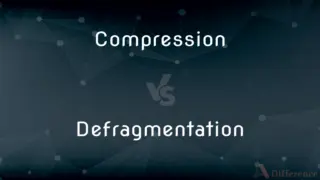Isogenic vs. Isogonic — What's the Difference?
By Fiza Rafique & Maham Liaqat — Updated on April 15, 2024
Isogenic refers to organisms with identical genetic makeup, often used in genetics; isogonic pertains to lines of equal magnetic declination on maps, relevant in cartography.

Difference Between Isogenic and Isogonic
Table of Contents
ADVERTISEMENT
Key Differences
Isogenic lines in genetics are used to describe cells, tissues, or organisms that have exactly the same genetic material. They are particularly important in research that requires uniform biological samples. On the other hand, isogonic lines, also known as agonic lines, are used in cartography and navigation to indicate areas on the Earth's surface where the magnetic declination, the angle between magnetic and true north, is the same.
When dealing with isogenic samples, scientists can ensure that any differences in experimental outcomes are due to the experimental conditions and not genetic variability. Whereas in the case of isogonic lines, these help navigators and geographers determine the exact alignment of magnetic north, facilitating more accurate compass readings and navigation.
Isogenic organisms are often created through specific breeding techniques or genetic engineering to serve as models in medical and biological research. In contrast, isogonic lines are identified through surveys and measurements of the Earth's magnetic field, which can change over time due to shifts in the Earth's core.
The concept of isogenic is central to genetics and is aimed at understanding biological processes in a controlled genetic environment. On the other hand, the study of isogonic lines intersects with geophysics and navigation, addressing how the Earth's magnetic properties affect global positioning systems.
In practical applications, isogenic lines are vital for creating genetically identical populations in laboratories, such as in the study of disease or drug effects in genetically identical mice. Conversely, isogonic lines are crucial for correcting errors in navigation systems, ensuring that electronic or traditional compasses accurately reflect geographic directions.
ADVERTISEMENT
Comparison Chart
Definition
Having identical genetic makeup
Having equal magnetic declination
Primary Field
Genetics
Cartography and navigation
Purpose
Control genetic variability in research
Correct compass errors, aid navigation
Creation Method
Breeding, genetic engineering
Geophysical surveys
Relevance
Biological and medical research
Navigation, geophysics
Compare with Definitions
Isogenic
Identical in DNA sequence.
Isogenic twins provide perfect subjects for genetic research.
Isogonic
Lines of equal magnetic declination.
Isogonic lines are mapped to aid global navigation.
Isogenic
Derived from a single genetic source.
Isogenic cell lines are used to study cancer progression.
Isogonic
Related to Earth's magnetic field.
Isogonic studies involve measuring magnetic variations.
Isogenic
Genetically uniform.
Isogenic populations eliminate variability in genetic studies.
Isogonic
Indicates zero magnetic declination.
An isogonic line can pass through areas of no magnetic deviation.
Isogenic
Pertaining to genetic sameness.
Isogenic strains of mice are crucial for consistent results in biomedical research.
Isogonic
Pertaining to equal magnetic angles.
Isogonic mapping helps pilots correct course.
Isogenic
Clonal origin.
Isogenic cultures in microbiology ensure purity and control in experiments.
Isogonic
Navigation aid feature.
Isogonic lines on a nautical chart guide mariners accurately.
Isogenic
(genetics) Having the same genes.
Isogonic
Having equal angles.
Isogonic
Describing imaginary lines connecting points on the Earth's surface of identical magnetic declination.
An isogonic line
Isogonic
(geometry) Having equal angles.
Isogonic
(zoology) Exhibiting, or relating to, isogonism.
Isogonic
An isogonic line; a curve connecting points on the Earth's surface whose magnetic declination is identical.
Isogonic
Pertaining to, or noting, equal angles.
Isogonic
Characterized by isogonism.
Isogonic
Having or making equal angles
Common Curiosities
What are isogenic lines used for in genetics?
Isogenic lines are used to minimize genetic variability in research, allowing scientists to focus on environmental or experimental impacts.
How are isogonic lines useful in navigation?
Isogonic lines help navigators correct for magnetic declination, ensuring compasses point to true north accurately.
How are isogenic lines created?
Isogenic lines are typically created through selective breeding or genetic engineering techniques to ensure genetic uniformity.
What causes the magnetic declination that isogonic lines indicate?
Magnetic declination is caused by variations in the Earth's magnetic field, influenced by the movement of molten iron in its outer core.
Can isogenic organisms occur naturally?
Yes, naturally occurring isogenic organisms can exist, such as identical twins, but they are also widely created artificially for research.
How often are isogonic lines updated on maps?
Isogonic lines are updated based on periodic surveys which may occur every few years to reflect changes in the Earth's magnetic field.
Are isogonic lines static on Earth's surface?
No, isogonic lines can shift due to changes in the Earth's magnetic field over time.
What are the applications of isogenic lines in medical research?
Isogenic lines are used in drug testing, disease model studies, and other medical research to ensure consistent genetic backgrounds.
Are there ethical concerns with creating isogenic organisms?
Yes, ethical concerns include issues of biodiversity reduction and the implications of genetic manipulation.
What tools are used to determine the location of isogonic lines?
Tools like magnetic compasses and sophisticated geomagnetic surveys are used to determine the location of isogonic lines.
Share Your Discovery

Previous Comparison
Intentional vs. Willful
Next Comparison
Compression vs. DefragmentationAuthor Spotlight
Written by
Fiza RafiqueFiza Rafique is a skilled content writer at AskDifference.com, where she meticulously refines and enhances written pieces. Drawing from her vast editorial expertise, Fiza ensures clarity, accuracy, and precision in every article. Passionate about language, she continually seeks to elevate the quality of content for readers worldwide.
Co-written by
Maham Liaqat











































